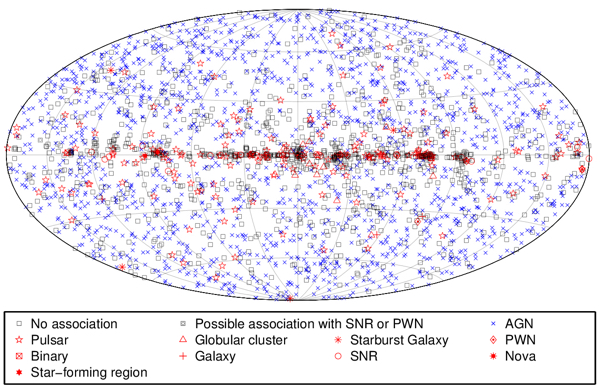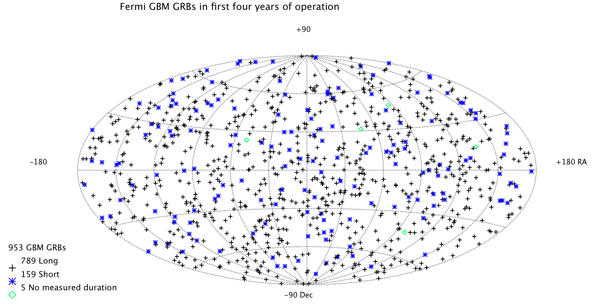Fermi Catalogs Facilitate Science
Astronomical catalogs provide a starting point for research, as shown in the box to the right. Because the Fermi instruments survey the sky continuously, they are ideally suited to producing both general and specialized catalogs.
The Fermi Science Support Center makes these catalogs available. See: http://fermi.gsfc.nasa.gov/ssc/data/access/
Ways in Which Catalogs Enable Scientific Research
- Discovery - unassociated sources are either previously unknown members of known source classes or something entirely new
- Population Studies - properties of whole classes of sources, such as their luminosity functions
- Correlated Variability Studies - compare activity in the gamma-ray band with multiwavelength observations; also ultra high-energy cosmic rays/high-energy neutrinos/gravitational waves
- Source Sample - to probe the Extragalactic Background Light/Inter-Galactic Magnetic Field
- Contribution - of Active Galactic Nuclei to the extragalactic diffuse gamma-ray background
The Third Fermi LAT Source Catalog (3FGL)

| Type | # Identified | # Associated |
|---|---|---|
| Pulsars | 143 | 24 |
| Pulsar Wind Nebulae (PWNe) | 9 | 2 |
| Supernova Remnants (SNRs) | 12 | 11 |
| Candidate SNR/PWNe | -- | 49 |
| Quasars (steep and soft spectrum) | 0 | 4 |
| BL Lac Blazars | 18 | 642 |
| Flat Spectrum Radio Quasars | 38 | 446 |
| Other Active Galactic Nuclei | 10 | 587 |
| Normal & Starburst Galaxies | 2 | 5 |
| Other* | 6 | 15 |
| Totals | 238 | 1785 |
| Unassociated | -- | 1010 |
The Second Fermi GBM Gamma-ray Burst Catalog

There is also a table of GRBs that have high-energy components detected by the LAT. This table is kept up-to-date by the LAT instrument team.
Wide Variety of Specialized Catalogs
In addition to all-sky catalogs, the instrument teams have performed more specialized analyses, focusing on specific source classes and using careful, systematic treatment of all the class members. As a result there are several publicly-available catalogs that are useful for studies of both individual sources as well as entires source populations.
- First High-Energy Gamma-Ray Source Catalog: An all-sky catalog tuned to detect only gamma-ray sources that are significant above 10 GeV.
- Second High-Energy Gamma-Ray Source Catalog: An all-sky catalog tuned to detect only sources that are significant above 50 GeV.
- Catalog of Gamma-Ray Pulsars: A catalog that uses timing information for known gamma-ray pulsars to perform analyses of both the ON and OFF pulse data. This provides much better characterization of the pulsar spectral properties, and can be used to search for underlying pulsar wind nebulae.
- Catalog of Gamma-Ray Supernova Remnants: This catalog reports the result of a systematic gamma-ray analysis performed at the positions of all known supernova remnants.


